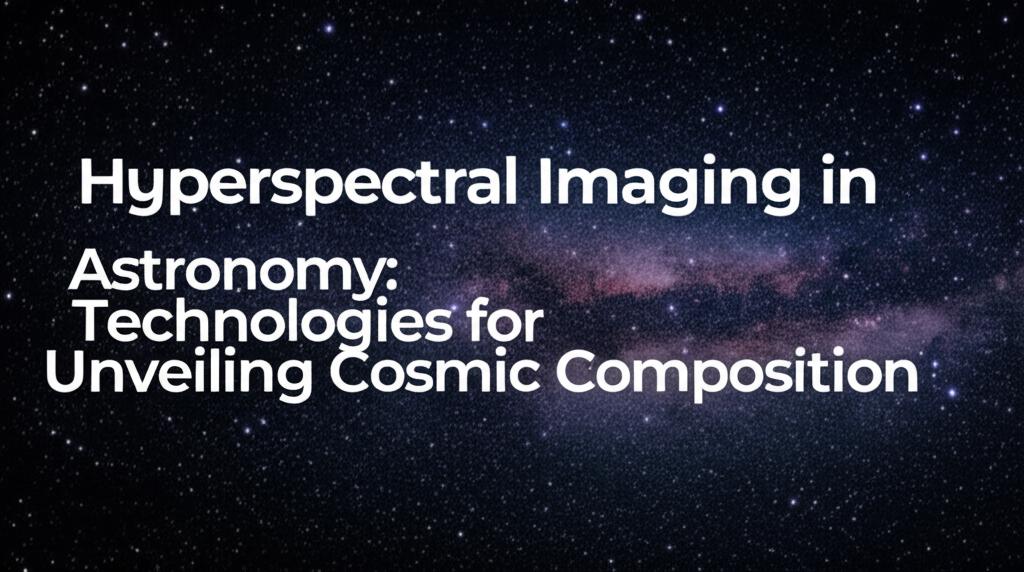Hyperspectral imaging is transforming our ability to study the universe, offering a powerful technique to dissect the light from celestial objects and reveal their chemical makeup, physical conditions, and movements in unprecedented detail. Unlike traditional imaging, which captures light in broad color bands (like red, green, and blue), or standard spectroscopy, which studies the spectrum of an entire object averaged together, hyperspectral imaging captures a detailed spectrum for every single pixel in an image. In astronomy, this powerful technique is commonly known as Integral Field Spectroscopy (IFS).
Decoding Cosmic Light: Spectral FingerprintsThe core principle behind hyperspectral imaging's power lies in spectral signatures. Every chemical element and molecule absorbs, emits, or reflects light at specific, unique wavelengths. These patterns act like "fingerprints" in the light's spectrum. By capturing hundreds or even thousands of narrow, contiguous wavelength bands for each point in its field of view, a hyperspectral instrument creates a three-dimensional "data cube". This cube contains two spatial dimensions (the image) and one spectral dimension (the wavelength information). Analyzing this data cube allows astronomers to identify the elements present in stars, nebulae, and galaxies, map their distribution, determine temperatures and densities, and even measure how different parts of an object are moving relative to us (kinematics).
Technologies: Integral Field Units (IFUs)The key technological component enabling this in astronomy is the Integral Field Unit (IFU). IFUs are sophisticated optical devices placed at the focal plane of a telescope that dissect the incoming light from a two-dimensional area of the sky and reformat it so that it can be fed into a spectrograph. There are three main types of IFU designs:
- Lenslet Arrays: These use an array of tiny lenses (microlenses) to divide the image into multiple small spatial elements. Each lenslet creates a tiny image that is then dispersed by the spectrograph.
- Optical Fibers: Bundles of optical fibers are used, where each fiber captures the light from a small portion of the field of view and guides it to the entrance slit of the spectrograph. Often, these are combined with lenslets at the input to optimize light collection.
- Image Slicers: These employ an array of small, thin mirrors ("slicing mirrors") positioned at the telescope's focus. Each mirror picks off a narrow "slice" of the image and redirects it to form a pseudo-long slit, which is then dispersed by the spectrograph.
Regardless of the method, the goal is to arrange the light from the entire 2D field onto the spectrograph's detector in a way that the spectrum from each spatial point can be recorded without overlapping its neighbors.
Cutting-Edge Instruments and DiscoveriesSeveral ground-breaking instruments utilize IFS technology:
- MUSE (Multi Unit Spectroscopic Explorer): Located on the Very Large Telescope (VLT) in Chile, MUSE uses 24 identical IFUs working together to cover a relatively large field of view. It has been revolutionary for studying galaxy formation and evolution, stellar populations, and the interaction between galaxies and their surrounding gas.
- NIRSpec on JWST (James Webb Space Telescope): The Near-Infrared Spectrograph on JWST features an IFU that provides the first opportunity for space-based integral field spectroscopy at near-infrared wavelengths (0.6 to 5.3 micrometers). This allows detailed study of distant galaxies, star-forming regions, and exoplanet atmospheres with unparalleled sensitivity and clarity from space.
- HARMONI (Extremely Large Telescope): Currently under development, HARMONI will be one of the first-light instruments for the upcoming Extremely Large Telescope (ELT). It aims to provide core spectroscopic capabilities for the world's largest optical telescope, enabling transformative science from detailed studies of exoplanets to observing the first galaxies in the universe.
Other notable instruments include SINFONI, FLAMES, and KMOS on the VLT, VIRUS on the Hobby-Eberly Telescope, and upcoming concepts like UMIS (Ultraviolet Micromirror Imaging Spectrograph) which may use micro-mirror arrays for adaptive field-of-view capabilities.
Analyzing the Data Cube and Future DirectionsThe output data cube allows astronomers to create maps of various properties across the observed object – maps of velocity fields revealing galactic rotation or outflows, maps of chemical abundance showing where different elements reside, or maps of ionization indicating the influence of hot stars or active galactic nuclei.
The future of hyperspectral imaging in astronomy is bright. Advances include building instruments composed of many replicated IFUs to cover larger areas (like MUSE and VIRUS), integrating IFS with adaptive optics for sharper spatial resolution, and developing instruments for next-generation telescopes like the ELT. There's also a push towards developing more sophisticated detector technology and potentially miniaturized hyperspectral systems, although cost and complexity remain challenges. The synergy between IFS instruments on large ground-based telescopes and space observatories like JWST is proving incredibly powerful for a comprehensive understanding of cosmic objects.
In essence, hyperspectral imaging, or integral field spectroscopy, provides astronomers with a multi-dimensional view of the cosmos, continuously revealing the intricate details of celestial objects and processes that were previously hidden.

